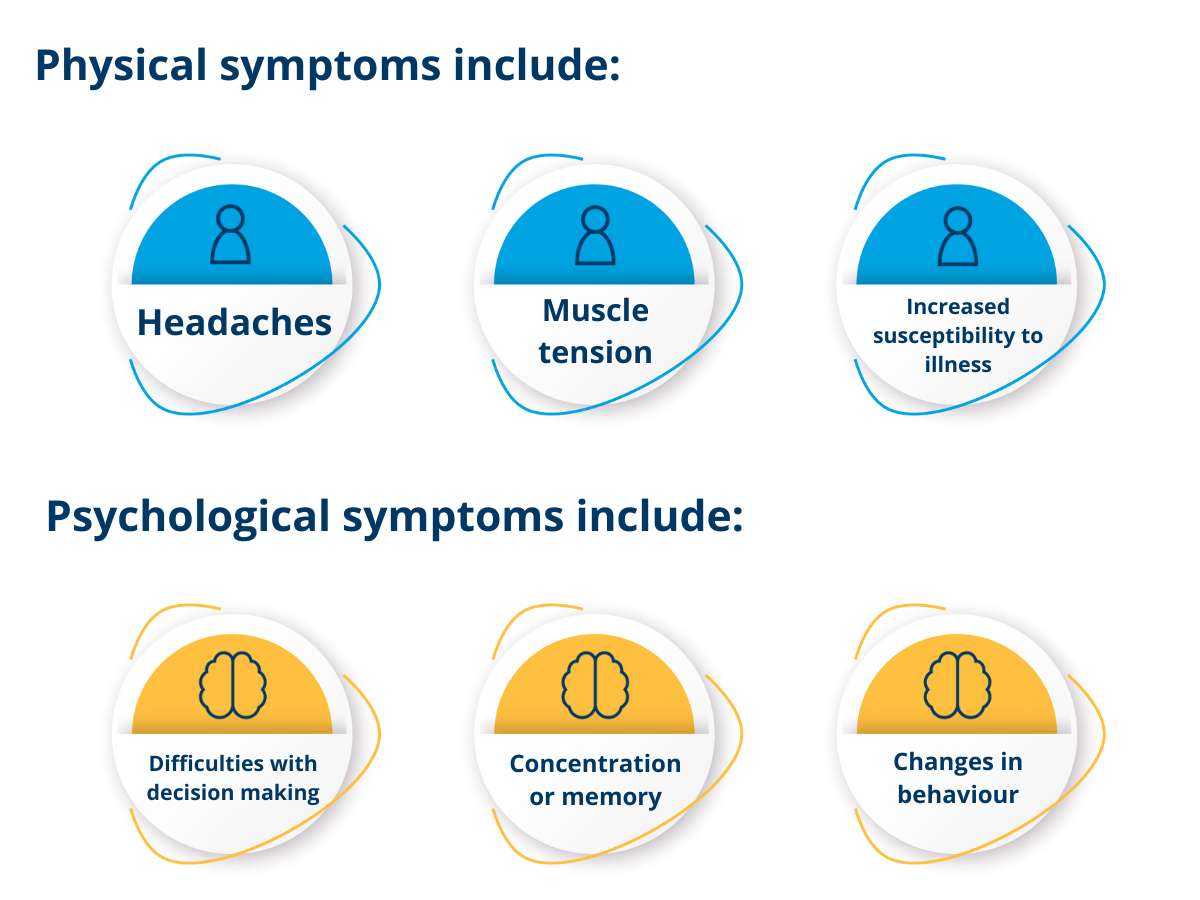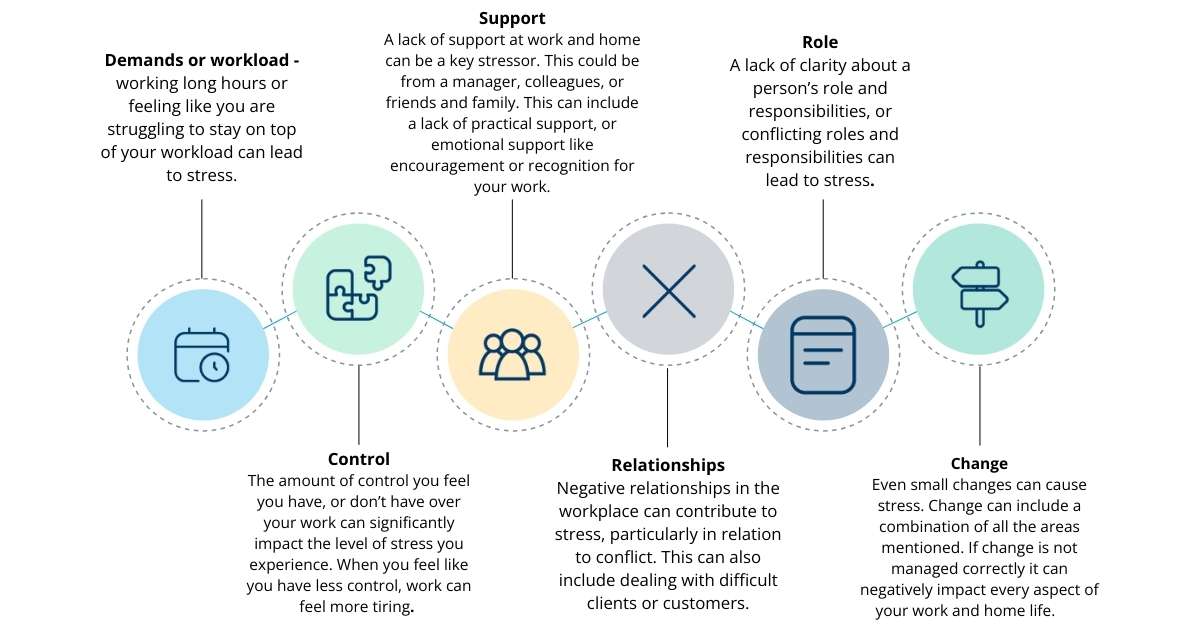Stress is a normal response to pressure or change. This response can be beneficial, helping us stay focused and motivated. Stress also triggers our fight-or-flight response which helps us escape dangerous situations.
However, in the wrong conditions, prolonged periods of stress can have a negative impact. Work-related stress can impact your physical and mental health, and the ability to perform your role. Understanding and managing work-related stress will help you, or your employees thrive at work.
Spotting the signs of work-related stress
Supporting your employees to manage their stress can help promote a positive working environment. When employee wellbeing is prioritised, there are also business benefits. These include:
- Reduced absenteeism and presenteeism
- Increased employee retention
- Boost in engagement and productivity
- Attract top talent
To tackle work-related stress, you need to know how to spot the signs and symptoms.
Common signs of work-related stress
Stress can show up in many different ways, including physical and psychological symptoms.

Negative effects of stress in the workplace
If your employees are struggling to manage stress at work, they may become more irritable, miss details or make mistakes that they would not normally make. They may feel like they are doing more work than others, or they may worry that they are not being as productive or performing at the level they should be.
Higher than normal levels of stress may lead to:
- Absences from work due to illness
- Turning to coping mechanisms like drinking, smoking or drugs
- Negative impacts on sleeping, eating and sexual patterns.
All of these can have a knock-on impact on performance at work.
It can be very difficult for a person to recognise that they are stressed or that stress is having a negative impact on them, their work, and their personal and professional relationships. A colleague or line manager may recognise that an employee is struggling before they do.
Acknowledging stress helps tackle it
Employees can sometimes feel that admitting to feeling stressed shows weakness. Letting them know that we all experience stress and it’s nothing to feel ashamed about helps them feel supported. When you acknowledge stress, identify the causes and take action to tackle it, your employees and your organisation benefits. Around 17 million days are lost at work each year due to stress at work. Studies have shown that putting strategies in place to reduce work-related stress can reduce absences by about one third.
Common causes of work-related stress
The Health and Safety Executive Stress Management Standards identify six areas of work that can contribute to stress. They can be a useful tool for recognising potential causes of stress:

Managing stress in the workplace
1. Awareness and acknowledgement
The first step in managing stress is recognising that employees may be struggling. Making everyone in an organisation aware of the physical, psychological and behaviour changes that can be associated with stress is an important step to addressing it. Being proactive, particularly around periods of change is important. Stress can be anticipated and managed before it becomes an issue.
The Health and Safety Executive (HSE) provides information and toolkits to help you implement stress risk assessments and tackle work-related stress head-on.


2. Facilitate conversation
Facilitating conversations about stress in a safe and positive environment helps employees open up. Recognising that everyone experiences stress can help people who are experiencing the negative side effects be more honest in their conversations.
The HSE Stress Management Standards can be used as a tool to help individuals think about the areas of their work that could be causing them stress and help to start a conversation. These conversations can be difficult but can also be very productive.
Employees experiencing high levels of stress may not be aware that they are struggling or what the underlying causes are. Challenges with workload and other demands are often the first thing your employees will point to as the cause of their stress. Through conversation, it may become clear that the root cause is a lack of support, or negative working relationships. There may also be factors outside of work affecting the person. When you can identify the underlying cause of stress, it can be much easier to manage.
3. Workplace adjustments to tackle stress
Identifying where adjustments can be made in the workplace to mitigate stress can help support your employees. The HSE Stress Management Standards can be used as a tool to help identify areas of work where adjustments would be most impactful.
It may not always be possible to manage all the factors contributing to stress. Many businesses have peak times of the week, month or year when demands are high and it is not feasible to allocate additional resources during these periods. Small adjustments to reduce stress and making sure employees feel supported and appreciated can go a long way.
Adjustments that can help mitigate stress at work include:
- Flexible working
- Regular breaks
- Mentoring
- Managing work volume
- Providing quiet spaces to work
There are a wealth of wellbeing and mental health resources, and tips available online to help manage stress alongside adjustments.

Let’s address work-related stress together
At Aim Forward, we provide assessments and personalised strategies to help you thrive at work and in everyday life. We can help you or your employees manage stress, whatever the cause. Through our Needs Assessments, we offer one-to-one support to help you understand how you learn and work. We’ll arm you with the support and strategies to help you excel.


Recent Comments